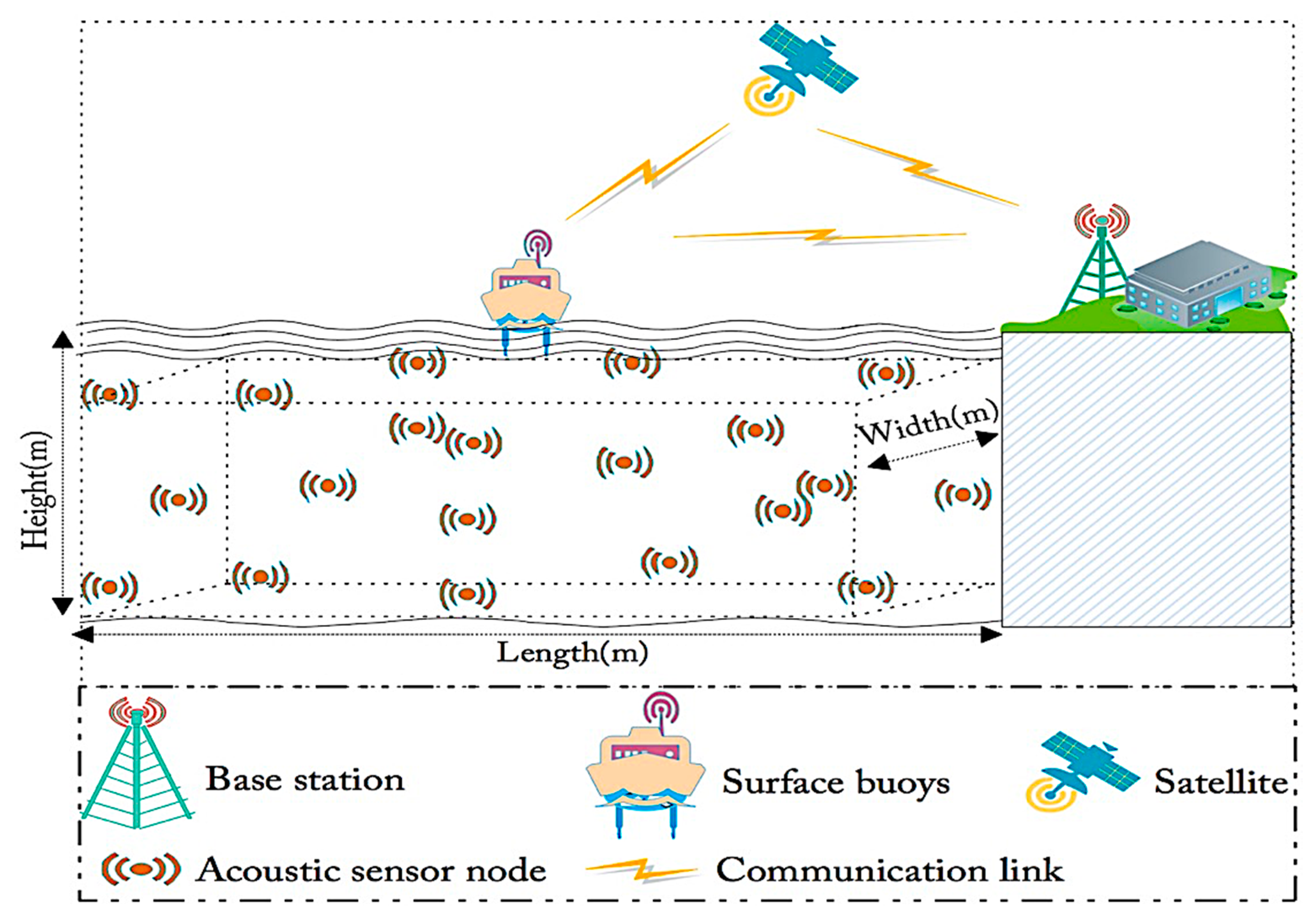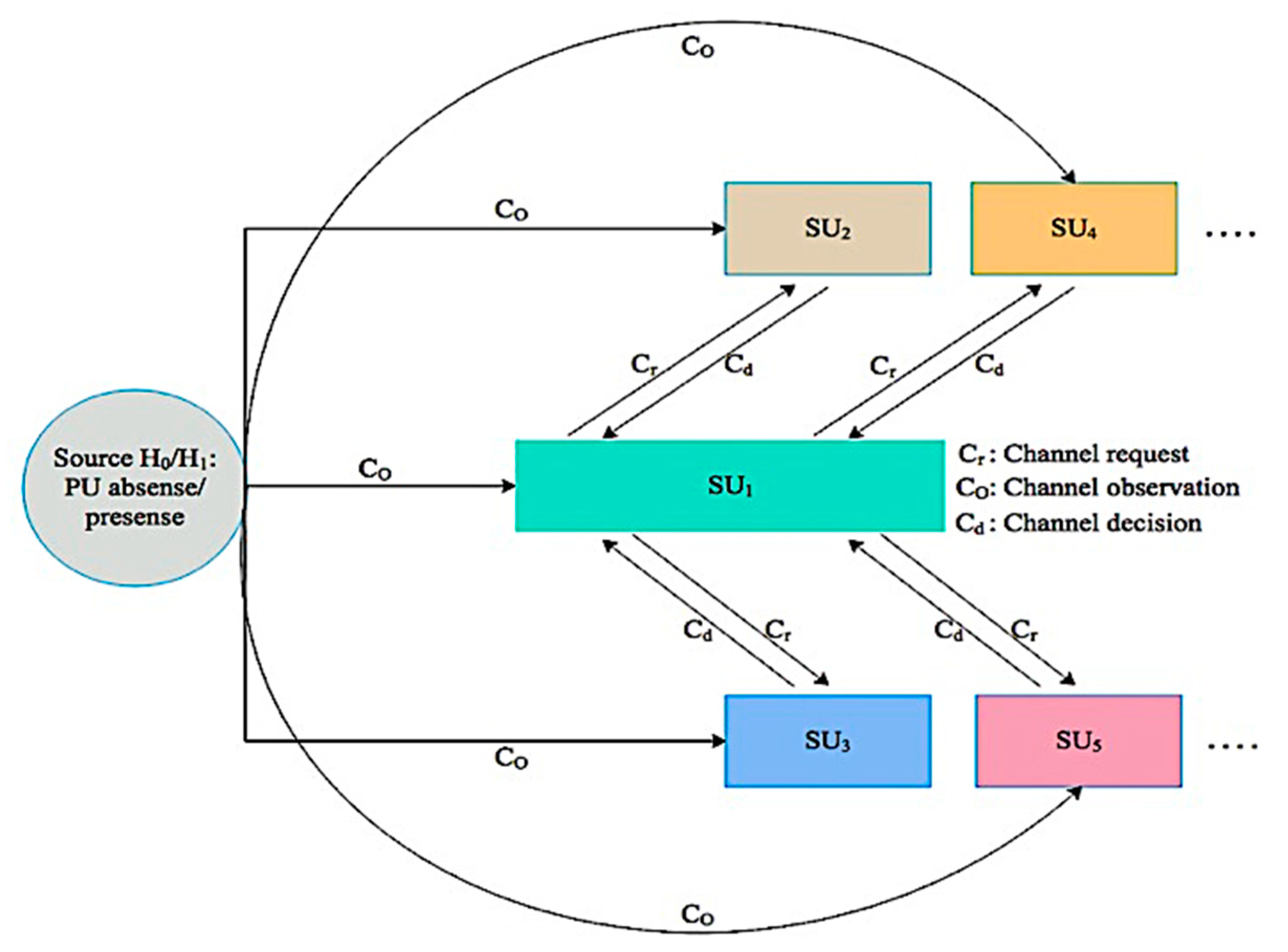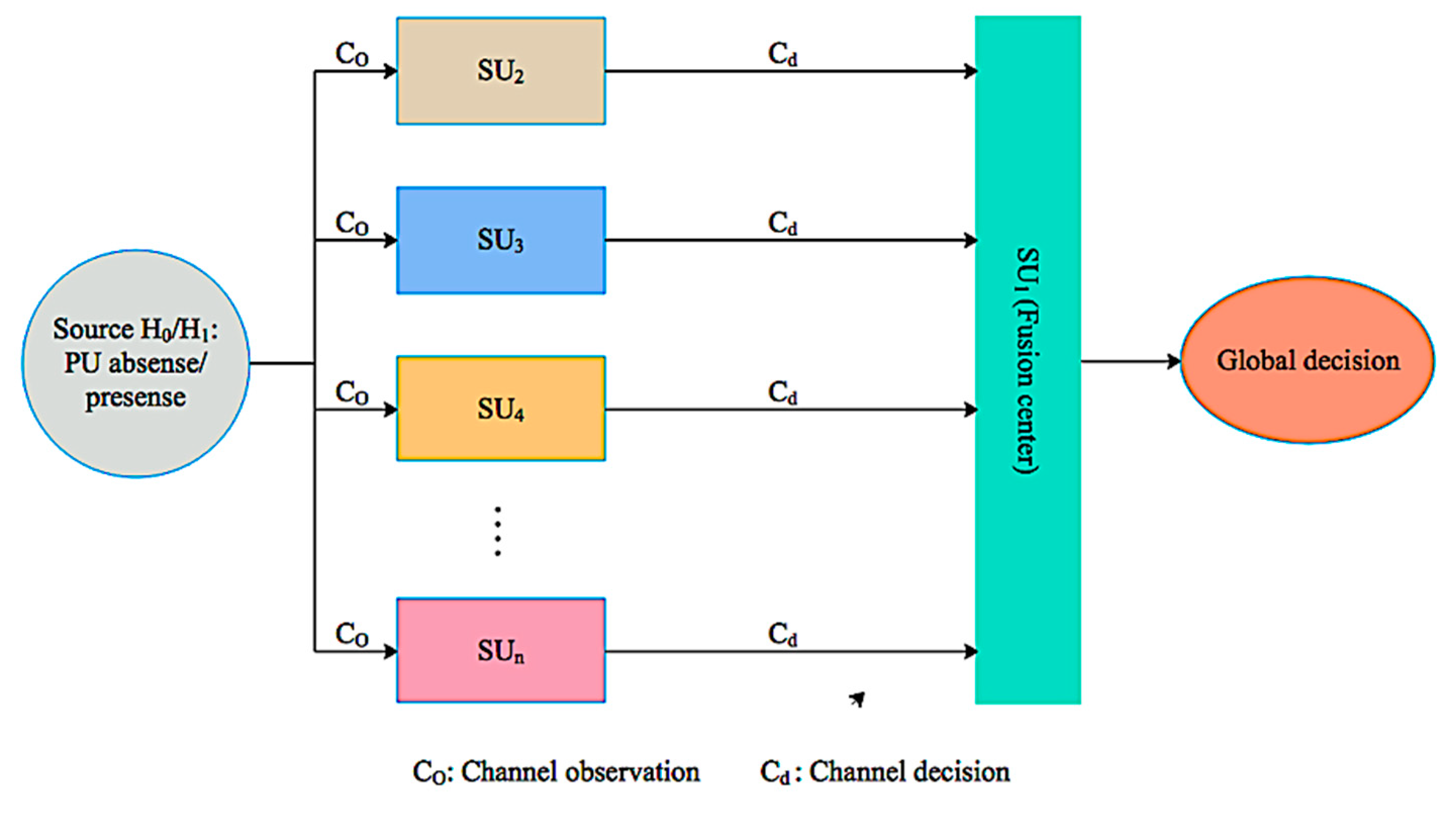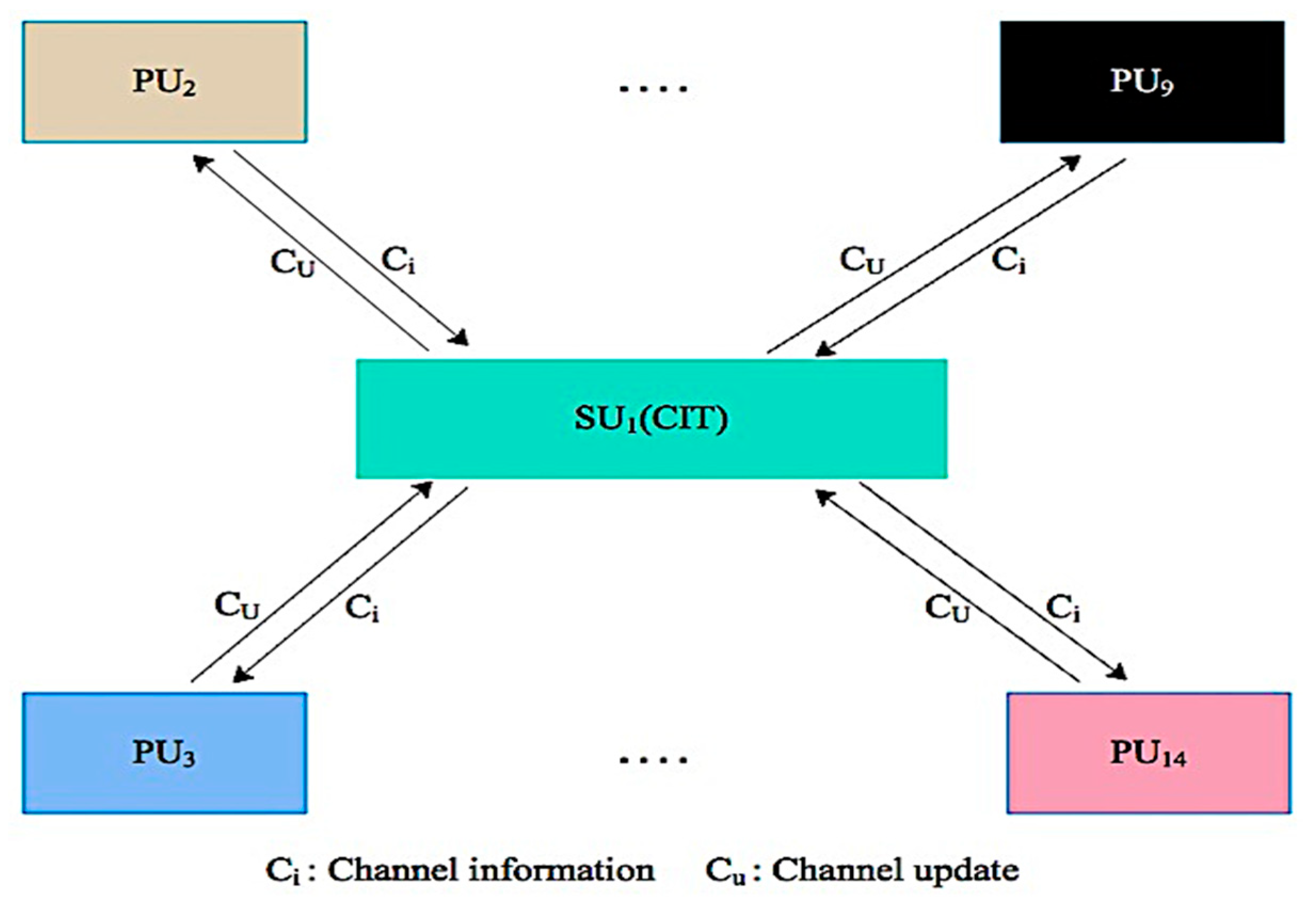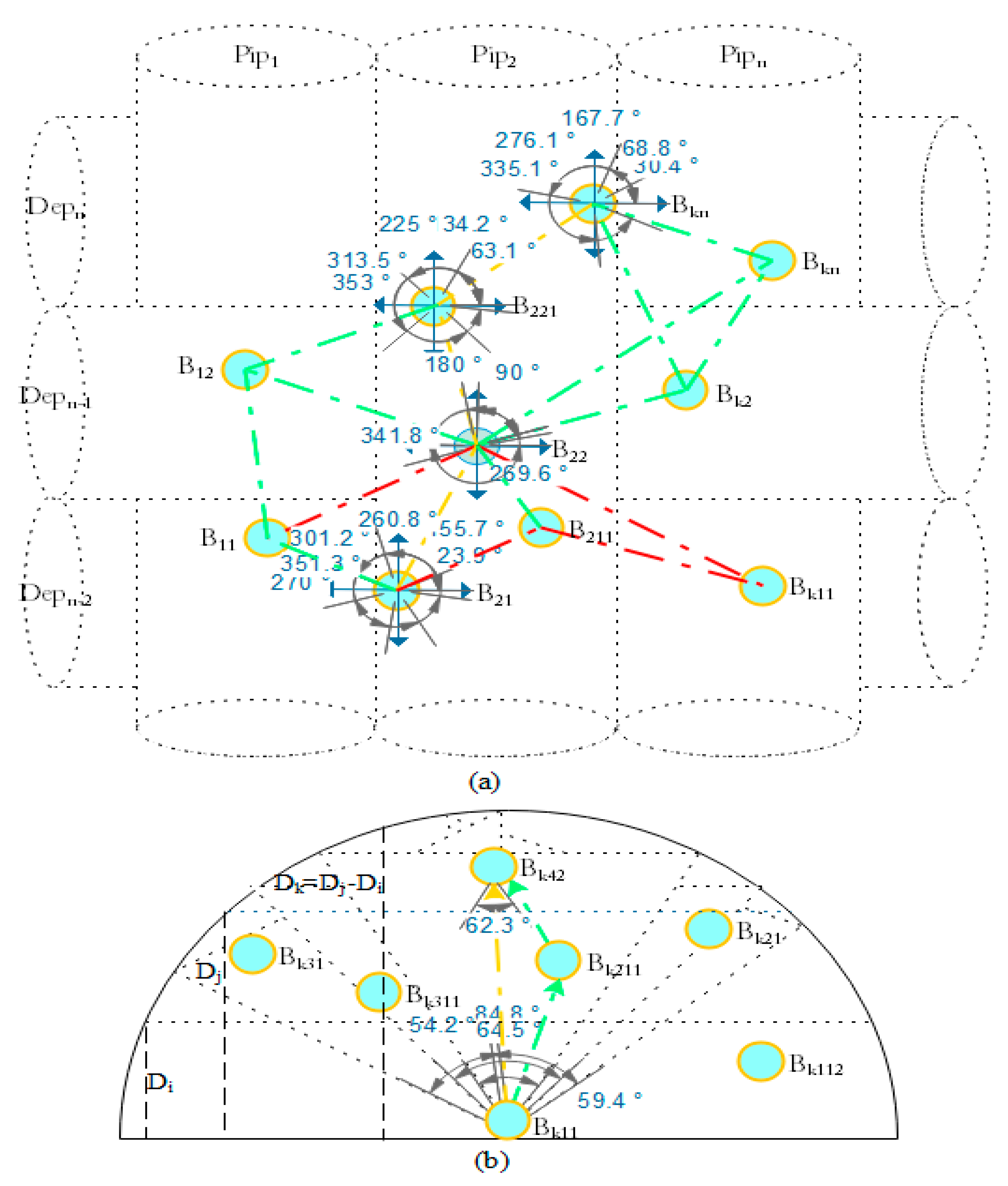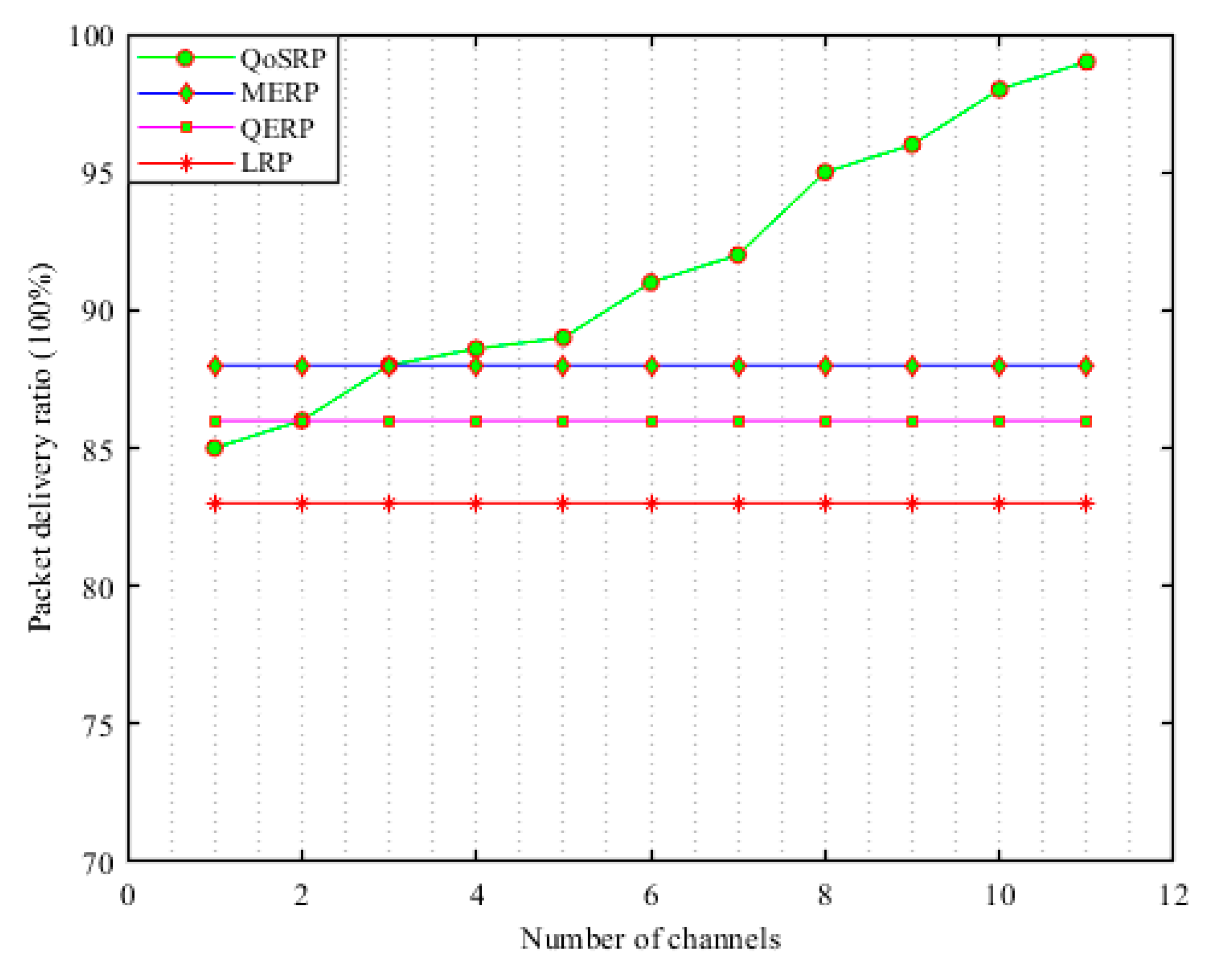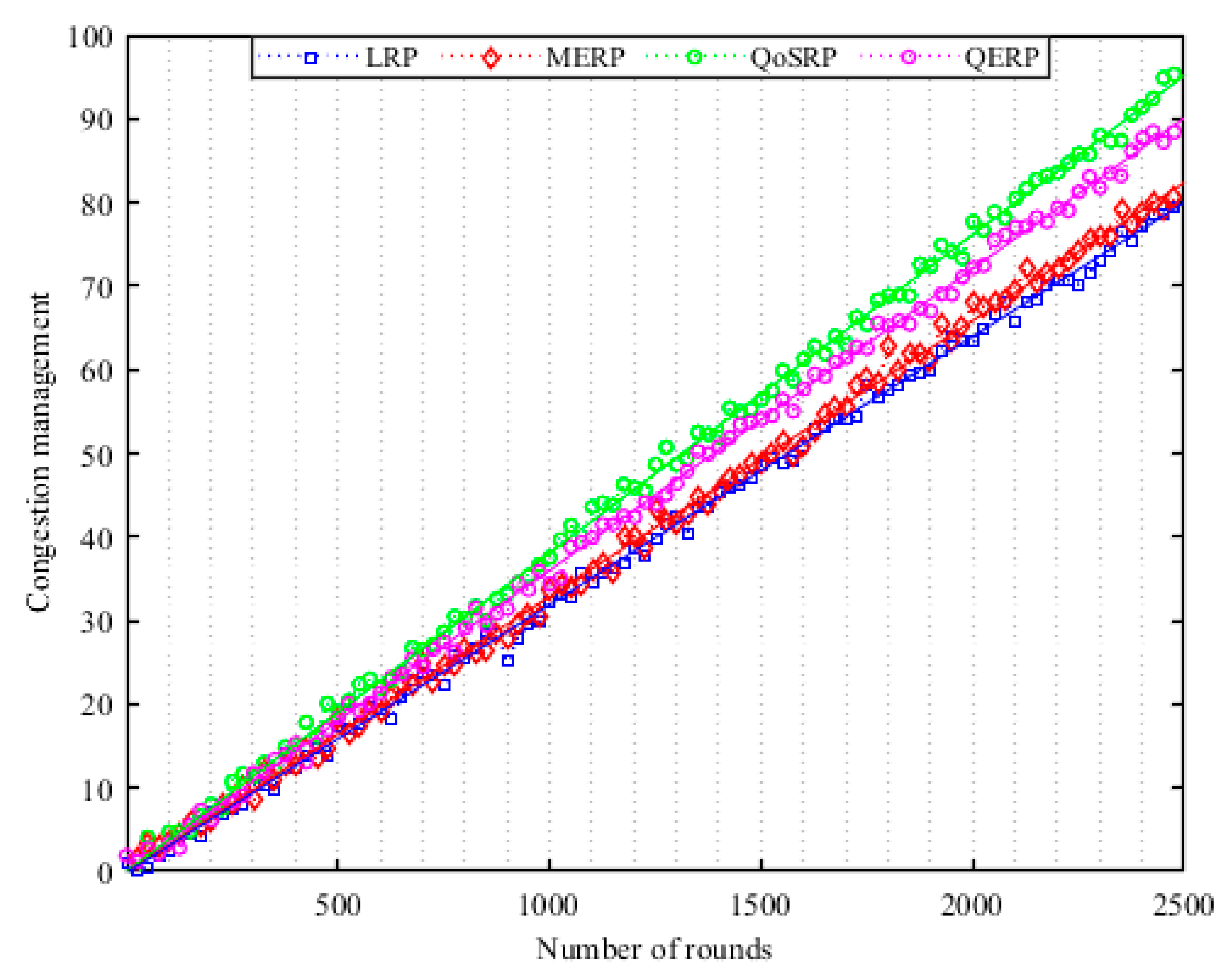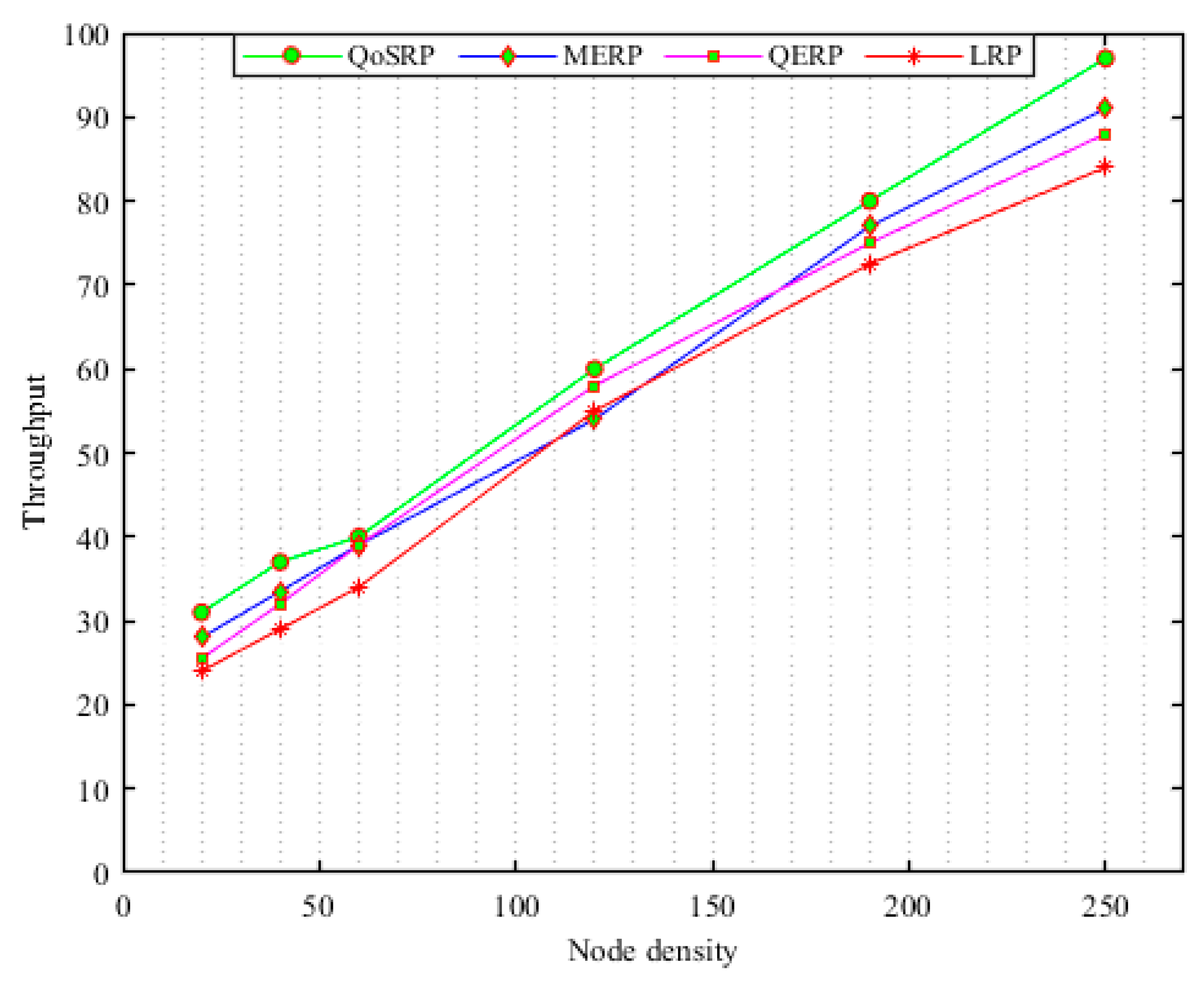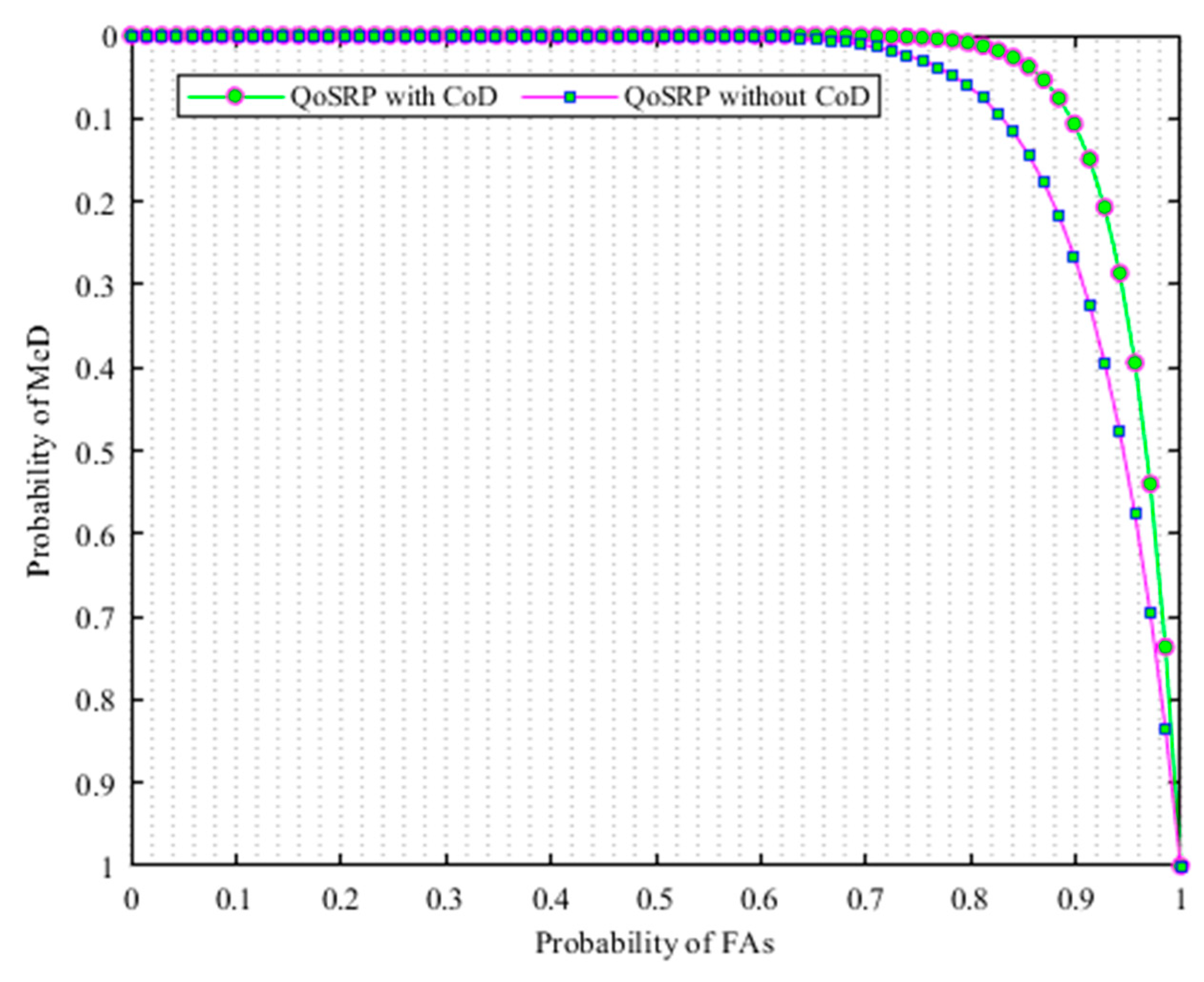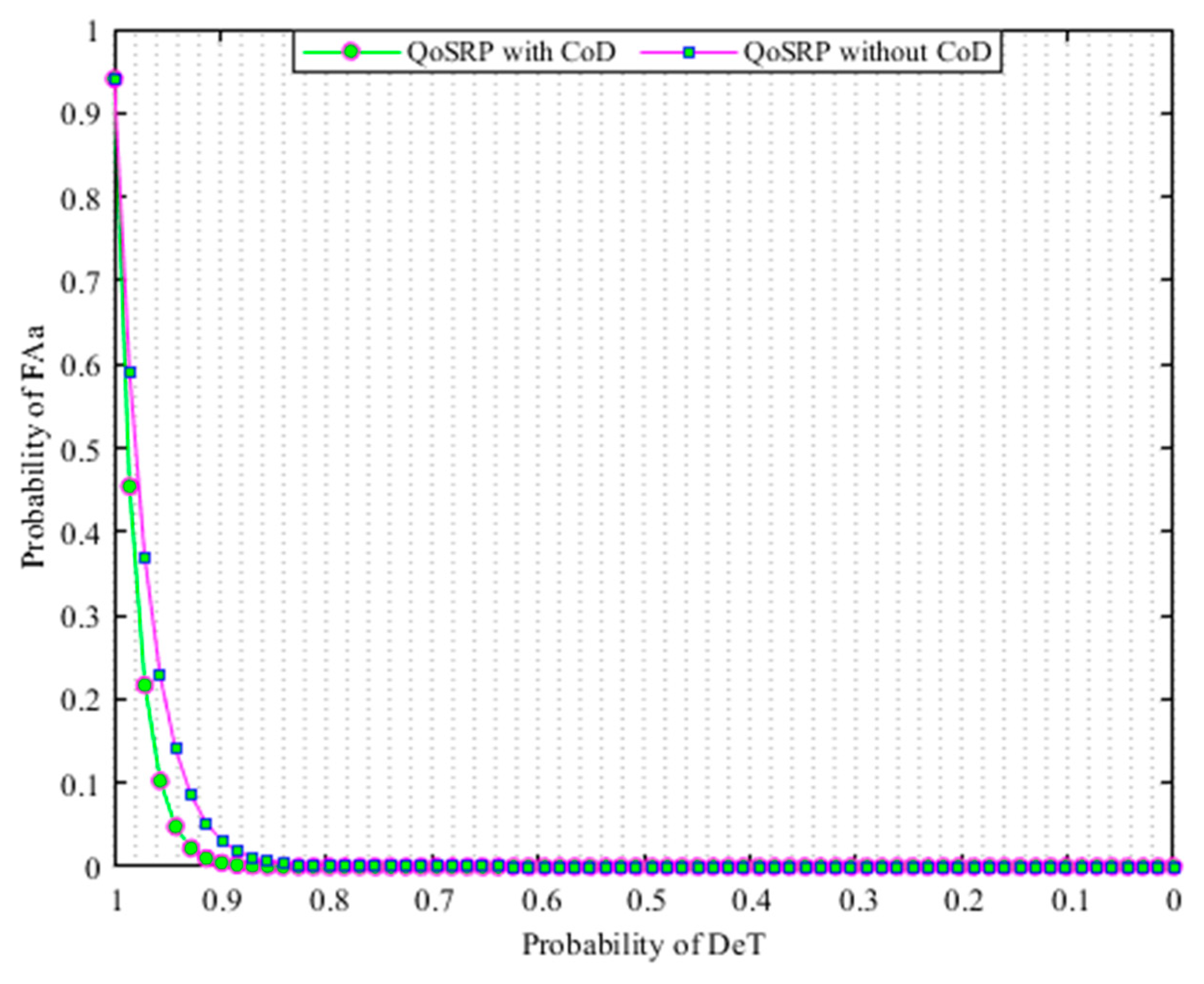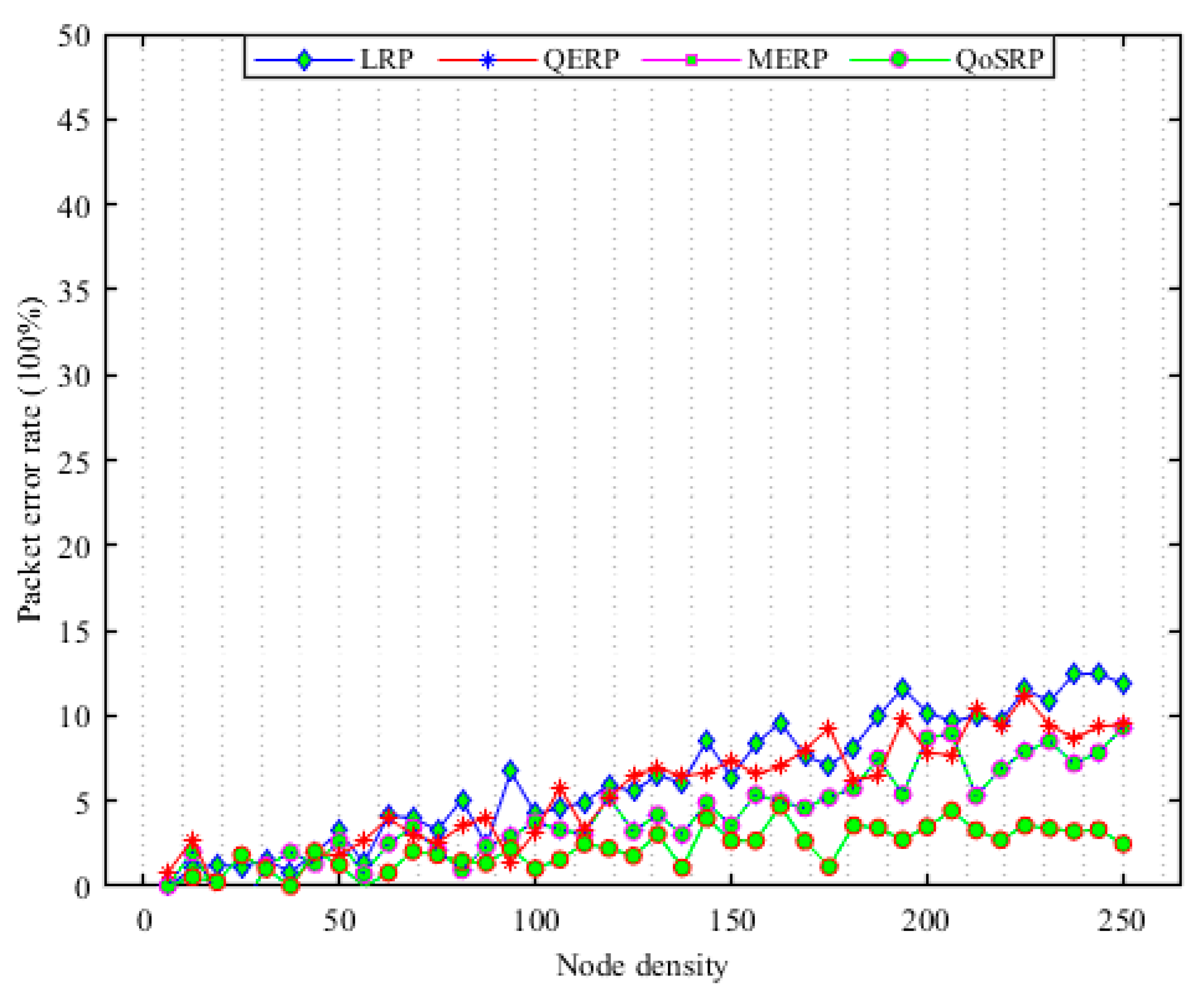The protocol design details are given in the following sections.
3.2. Underwater Acoustic Channel Detection (UWCD) Algorithm
Recently, the spectrum shortage problem aggravates in an apparent manner because of increasing demands for higher data rates at low frequencies for various UWSN-based applications. The principle of dynamically exploiting the local vacant spectrum bands of the primary users during their silence periods by secondary users is among the best-proposed solutions for this problem. Therefore, the multichannel is proposed as a prominent technology to implement spectrum access for its autonomous, agility, and ability to detect the primary user’s (PU) signal. In multichannel communications, the spectrum sensing is a key element in the sense that it demonstrates how signals of the PUs are identified, sampled, and processed for detecting spectrum holes [
33]. The main tasks accomplished by spectrum sensing, such as spectrum monitoring, spectrum analysis, and spectrum decision while the multichannel cycle consists of four core operations, including the above three and data transmission. Thus, the key aim of the spectrum sensing is to search spectrum holes for secondary users by detecting the primary signals in the network. To sense the accessibility of certain portions of the frequency band, the most effective way is to identify the primary users that are active within the range of a secondary user. However, the direct measurement between a transmitter and receiver for a channel is difficult and brings several new challenges for the secondary users in the UWEs. Generally, there exist few signal detection techniques like matched filter detection (MaD), wavelet detection (WeD), cyclostationary detection (CyD) and energy detection (EnD) [
34], etc., that can be employed during sensing the spectrum to enhance the detection probability in the UWEs.
In the MaD technique, the
have the prior knowledge of the
signals and a matching filter is applied, which amplifies the SNR of the received acoustic frequency samples. This mechanism, due to coherent detection, achieves a high processing gain and thus reduces the channel detection latency. However, each primary user class requires a dedicated sensing receiver, which is expensive and consumes significant ASNs battery power in UWSNs. Moreover, the channel detection performance of the matched filter can be severely limited because the primary user
signals information is hardly available at the
in UWEs. By contrast, in the WeD approach, the given signal is first split into various frequency components and later every component by matching the resolutions to its scales is studied. The wavelet detection basically employs cosines and sines as key functions [
35]. The use of irregularly shaped wavelets in the wavelet transforms as basic functions to identify the local features and sharp changes. This approach offers flexibility in dynamic channel adaptation and low implementation cost. However, the high sampling rates for characterizing the large bandwidth is one of the most critical challenges while implementing the wavelet approach. In the CyD technique, the presence of primary users can be identified even at very low signal-to-noise values by observing the periodicity of the collected
signals in UWEs. In the cyclostationary detection to obtain the periodicity of the primary signals, the modulated signals are usually combined with hopping sequences, spreading code, pulse trains, and cyclic prefixes or sinusoidal carriers. These modulated signals due to exhibiting the characteristics of periodic statistics and spectral correlation are characterized as cyclostationary [
36].
Typically, these features in the signal format are introduced intentionally, which enables a receiver to exploit parameter estimation like the direction of arrival, pulse timing, or carrier phase. This detection technique can improve the sensing detection, however, it requires prior knowledge of the primary signal characteristics. In addition, the high computational complexity and significantly extensive sensing delays are the other shortcomings of this approach. The EnD is the widely used channel detection method, which does not require any previous knowledge of the signals. This method identifies the primary user’s signals based on the sensed energy, where the received signal strength indicator or acoustic-frequency energy is computed to find whether the channel is free or not. Initially, an input signal to obtain the required bandwidth is filtered through a band pass filter and then the obtained signal is squared and combined over the observation interval. Lastly, to find the presence of a primary user signal a predetermined threshold is compared with the output of the integrator. Generally, fast Fourier transform-based techniques are used to analyze the spectral in the digital domain. In particular, in a specific time window, the received signal is sampled and passes through fast Fourier transform equipment to obtain the power spectrum. Then, the power spectrum peak after windowing is detected in the frequency domain. This technique provides better channel detection in underwater since it does not need any previous information about the signals. However, the high noise, interference, fading, and multipath effects increase the probability of sensing errors in terms of false alarms or miss-detection , which leads to poor channel detection performance in UWSNs. Hence, it is highly desired to reduce the sensing errors during channel detection to enhance the usage level of the vacant channel and to minimize the collision probability with transmissions.
In this respect, the detection threshold that precisely detects the presence of primary signals plays an important role in the multichannel acoustic sensor networks (MCASNs). The less error in computing the SNR value decreases the probability of
in UWEs. However, there exists a limit for the noise level. The increase in noise level above this limit increases the probability of
while it reduces with the decrease in noise below this threshold level. In the proposed scheme, the channel detection threshold level is determined by considering the various underwater environment parameters and set to a minimum level of the transmitted signal power value in the underwater. This detection sensitivity identifies the received SNR ratio at the secondary user
with a satisfied probability of detection conditions in MCASNs. Thus, the optimal channel detection threshold significantly reduces the sensing errors, enhance spectrum utilization and provides enough protection to
transmissions in the MCASNs. In the designed scheme, a simple and effective energy detection mechanism appropriately detects the existence of the
signal based on its received energy by comparing it to a detection threshold. Herein, we employ an energy-based signal detection
method revealed in [
37] to identify idle spectrums in UWSNs. The key objective function of the EnD mechanism
of the proposed algorithm is numerically indicated as:
The key aims of the objective function is to maximize the probability of detection
and minimize the probability of
and missed-detection
in UWSNs. Consequently, the test statics of energy detection
of the received signal at the
can be numerically written as:
subject to:
In Equation (2),
and
are, the received signal energy and the
-sample of the
while
is the sum of the length of
samples over an interval which helps to obtain a level of performance under certain
conditions in the network. The number of samples collected by individual
depends upon the sensing time and the longer sensing delay within in predefined time intervals leads to better detection performance of the primary signals. However, the longer sensing time results in less available time for packets transmission, which minimizes the throughput of the
is constrained by Equation (2a). Moreover, due to additional sensing time the cooperation overhead with the increasing number of cooperating users’ increases, which lead to a huge volume of information that need to process by the requested
to make a local decision is constrained by Equation (2b). Therefore, the number of samples of the received signal energy of
such that
using the central limit theorem over an interval are considered to obtain some level of performances under certain
conditions is constrained by Equations (2c) and (2b) in the network. Therefore, it is indicated as one of the basic functions of the
in the UWEs. The transmission of
signals is a random process, which follows an independent identically distributed pattern with mean zero and variance
. In the underwater, the noise
is a real-valued Gaussian variable that considers various underwater environment parameters with zero mean and variance
is constrained by Equation (2e) within a certain error probability. Constraints in Equations (2f, h) satisfy the limits in the network. To this end, the
in the underwater at the
secondary user
is computed as
. The primary user signal and noise are assumed to be independent and therefore a binary hypothesis testing problem of received energy signals at the
can be formulated as:
in which
,
,
are the time-bandwidth product, the channel gain between
and
, and noise in the
time slot, respectively. The received energy at each
is compared to the predefined detection threshold
to reach a decision about the presence or absence of
. In locally sensing mechanism each
decides whether the
channel is available (
or occupied (
) by using a predefined threshold in the network. Thus, the hypothesis at each secondary user is saying that the
is active only if the received signal energy is greater than the defined limit and idle when it is less than the defined threshold value, which can be numerically indicated as:
subject to:
in which
is the threshold value of energy is used to compare is the local spectrum sensing decision of a
,
denotes the
channel is not available because of the
activity with probability
in the sensing time
is constraint by Equation (5a). Equations (5b) and (5c) constraints guarantee that the
is active and inactive for a particular channel
in a time interval in the network. Equation (5d) constraints state that a channel belongs to the
is available to
for the time
, while the constaints in Equation (5e) satisfy the satement specified in Equation (5d). Constraints in Equation (5f) verify that the
senses a channel
in the region
and holds the channel for a specific time once it is found free in the network. Constraints in Equation (5f) explain that the
must not hold the channel for the entire time since the
can reclaim the channel any time in the network. Constraints in Equation (5h) state that the
senses a channel
in a region
and will not be sensed the same channel immediately once it is found busy in the network. On the other hand,
illustrates that the
spectrum is available with probability
, i.e.,
in the sensing time
. The performance of locally detecting spectrum by each
is computed by the probability of detection when a
is idle and the probability of
when a
is active and can be numerically expressed as
Equations
,
and
show the
probability when
determines
when
exits, the
probability when
decides
but
exists, and the
probability when
decides
but
exists, respectively. In addition, Equations
and
clearly indicate that
provides reliable protection to
when the detection probability is high while the
loses spectrum access opportunities when the false alarm probability is high in the network. Some common numeric terms used throughout the paper are given in
Table 2.
3.2.1. Decision Rules for the Fused Information in Distributed Cooperative Sensing (DCoS)
Distributed cooperative spectrum sensing consists of main two types of data fusion, namely hard decision and soft decision mechanisms in the MCASNs. The soft decision mechanism due to heavily sharing test statistics faces excessive cooperation overheads compared to the hard decision mechanism, which consumes the sensor’s energy and increases the probability of channel assignment delay in MCASNs. On the other hand, the hard decision mechanism performs best when the channel state information between the
and
varies in time and location in UWEs. The hard decision mechanism after considering the individual
local decisions conveniently applies the linear fusion rules such as AND, OR, and K-out-of-M to obtain a reliable cooperative decision. In the AND fusion rule, the fusion center declares
only if all independent
decide on
and declares
for the OR rule only if any of independent
decides on
in the cooperative decision. On the contrary, the fusion center in K-out-of-M rule declares the ultimate decision that there is a
transmission only if at least K secondary users out of M selected local detectors decide about the presence of a
signal. In the proposed scheme, the probability of
,
and
using K-out-of-M rule can be written as:
Equations , and illustrate the probability of when all secondary users sensed the existence of a such that determine when exits, the probability when the secondary users decides but exists, and the probability when the secondary users decide but exists, respectively.
3.2.2. Distributed Cooperative Sensing (DCoS)
In the UWCD scheme, the local channel detection made by the individual for the desired capacity-aware channel is preferred. However, the high underwater noise, fading, and interferences have destructive effects caused by imperfect reporting channels on the wireless link quality leading to poor cooperative spectrum sensing in the network. This problem becomes more severe between the sender and the receiver secondary users due to an increasing probability of errors over the reporting channels of the transmitted signal in the network. Therefore, finding a channel with high data rates become more difficult in local spectrum sensing in UWEs. To this end, the distributed cooperative sensing (DCoS) provides better results in highly dynamic UWEs. The in the proposed DCoS architecture performs the channel sensing tasks on demand only if the required capacity-aware channel is not found locally by the . To do so, the that requires the channel information sends multicast request messages to its neighboring ASNs. The request message includes the required channel information, identity, and location information in the network. Upon receiving the request message, the neighboring start to sense the required channels and share their channel detection statistics by exploiting the spatial diversity in the observations. Thus, each based on its local sensing observation exchanges decision on the existence or non-existence of the primary signals in the UWSNs.
The receiver
combines the received sensing information with its own information and after some necessary calculations makes an ultimate decision whether the
is active or not in the network. This decision information is disseminated to each sender
in the network. This combined decision mechanism significantly improves the performance of channel detection and relaxed sensitivity requirements for the
in the network. Thus, each receiver
acts as a fusion center as shown in
Figure 2. In
Figure 2, a
that requires a specific channel/s information sends a request message to its neighboring nodes. The neighboring
after successfully receiving the request message start to observe the channel activity in the network. Then each
based on local observation decides the presence or absence of the primary signal and forwards its final decision to the request
by considering the CSMA mechanism in the MCASNs. The selected
perform channel detection in a group manner in a way such that if required then more than one channel are sensed in parallel in every sensing interval as shown in
Figure 2. During the information exchange process, an acknowledgment message is forwarded by the receiving node, which guarantees that the information has been received successfully.
This mechanism significantly reduces the cooperation overhead in terms of latency for searching an appropriate spectrum since multiple channels are sensed in a single sensing interval. Moreover, it also significantly minimizes the network implementation cost by eliminating the need for centralized intelligent devices in the UWSNs. In addition, the fusion mechanism improves the robustness of the decision-making process at the fusion node on the presence or absence of
in UWSNs. The cooperative decentralized parallel channel sensing architecture of our proposed scheme is indicated in
Figure 3. It illustrates that different
observe the designated channel/s and each of them makes an individual decision and forwards its one-bit decision to the fusion center in a parallel manner in UWSNs.
3.2.3. User Selection in Cooperative Mechanism
In UWSNs, the fusion center cooperating with all users does not essentially attain the optimal performance since the channel fluctuates over time and location due to the harsh nature of the UWEs. This might lead to assigning a poor-quality channel to the
which degrades the performance of the network. Therefore, the selection of
for obtaining the decisions for specific primary signals plays an important role since it can be used to increase the sensing performance at the fusion center. Thus, the most appropriate
among the others which have better
probability by considering a given
probability in a region must be given the opportunity to participate in the DCoS. In the UWCD scheme, the appropriate cooperating
raise the probability of
and minimize the total error probability for the
, and thus improve the total throughput of the network. In addition, it provides sufficient protection to the
in terms of interference in the network. A set of secondary users selected
from the rest of the secondary users
in the decision-making procedure can be numerically shown as:
subject to:
Constraints in (12a) state that the selected secondary users are less than the total number of secondary users involved in the sensing process for the distinct channels in a region in the network. Constraints in (12b) guarantee that the selected secondary users perform the best in terms of channel detections with low error probability is satisfied by Equation (12c). Constraints in (12d) state that the secondary users with poor detection probability are removed from the channel detection group in the network. Constraints in (12e) make it sure that the selected secondary users detect the channel in predefined time intervals .
3.2.4. Sensing Overhead at the Fusion Center
The local sensing and data reporting to the fusion center spend a notable amount of
energy in the MCASNs. In this respect, the limited sensing information by following certain criteria or constraints, which avoids unnecessary or uninformative data reporting can significantly improve energy efficiency in cooperative detection in the MCASNs. Realizing the facts, the proposed scheme employs a few sensing bits from each neighboring so that
is reported to the requested
in the MCASNs. This notably reduces the average number of sensing bits reported by the selected neighboring
to the fusion center in the MCASNs. In the proposed scheme, each
after capturing the primary signal sample computes its energy and detects the presence or absence by comparing with the defined threshold value. Then, a one-bit decision 0 for idle and 1 for active with the channel information is sent to the fusion center. However, if no decision is made by the neighboring
then it simply drops the request without reporting the fusion center. The excessive number of
with no reply may degrade the false alarm probability but the reported local decisions are significantly reduced in the proposed scheme, which saves energy, latency, and processing time consumed in the decision-making process. However, after predefined iterations, if there is no reply for these
in the specific time intervals then they are removed from the channel detection and reporting group list by the fusion center. Consequently, the fusion center combined the neighboring
information and computes the combined likelihood ratio like in a Neyman-Pearson test
to make the final decision on the presence or absence of the primary signals which can be numerically indicated as
in which
shows that there are
number of
and the observations at each
are indicated by
such that
at the fusion center
such that
and
is the defined threshold value. This mechanism guarantees the target probability of false alarm while maximizing the probability of detection when making a global decision for the presence or absence of the
on a channel in the MCASNs. To further enhance the probability of detection, the fusion center adds only those
in a group whose detection probability are higher than others above the defined threshold. The fusion center periodically computes the detection probability of each
based on its measurements in different rounds and updates its table. Thus, a fewer
with the highest detection probability sense and provide the most accurate results with reduced sensing overhead in UWSNs.
3.3. Underwater Acoustic Channel Assignment Algorithm (UWCA)
The
for a channel
sense the temporal non-existence of the
and find this channel busy if occupied. The
must leave the detected channel
and immediately switch to an alternative channel
by identifying the spectrum holes for transferring packets in UWSNs. The spectrum detecting approaches to find vacant spectrum bands can be categorized into a cooperative (CoS) and non-cooperative (NCoS) in UWSNs. In the CoS approach, the secondary users sense the vacant channels and cooperate closely with the neighboring secondary users to make the decision for the vacant channels in the network. In the NCoS, a secondary user makes the local decision for the vacant channels based on its own spectrum measurement in the UWSNS. The cooperative sensing can be individual (ICoS) or group-based (GCoS) sensing. In the ICoS mechanism, some randomly selected ASNs monitor the data transmission activities of a specific channel independently. By contrast, in the GCoS approach, a set of predefined ASNs is assigned to monitor the activities of a channel in a group. Consequently, the cooperative sensing based on the architecture can be divided into two types, namely centralized cooperative sensing (CCoS) and decentralized cooperative sensing (DCoS) [
38]. In the CCoS approach,
for a channel
sense the temporal nonexistence of the
and send their local observation data to a specialized fusion center, which combines the received channel results and decides the use of the channel
for packets transmission. The specialized fusion centers periodically forward the local decision updates to neighboring specialized devices since they are aware of the existing vacant channels at any given time.
Thus, the key aim of the specialized devices is to allocate vacant channels efficiently to
with least information message-sharing in the UWSNs. On the contrary, in the DCoS approach, secondary users sense the vacant channels and cooperate closely with the neighboring secondary users and make the decision without using the centralized device for the vacant channels in the network. The CCoS can considerably intensify the systems aptitude in identifying and evading the
signals in the network. However, it faces several issues such as high information exchange overheads and particular region cut off issues due to a single expert device failure, and overall network deployment cost due to the high price of these controllers. Thus, it could not be the best choice for the UWSNs. In this respect, the DCoS approach due to its flexibility in deployment for autonomous decision making seems to be the best choice for UWSNs. In DCoS, a set of
without the coordination of the centralized expert devices locally detects the
signals and maintains the spectrum information to make the decision by itself. In the proposed scheme, the DCoS overcomes the drawbacks of CCoS, but the sensing capabilities of
in DCoS are usually limited due to software-defined hardware limitations such as low computation, signal processing, memory, etc. The DCoS is further divided into restricted spectrum sensing (DRS) and whole spectrum sensing (DWS) [
39].
The DRS allows secondary users to sense for the vacant channels in a specific region. Although, secondary users sequentially sense the specific region for available channels might raise the probability of detecting an available channel more quickly. However, the possibility of finding a poor capacity-aware channel with high interference also arises that affects the neighboring ASNs leading to low link qualities in the network. This results in packets loss, significant delay and degrades secondary users’ throughput in the network. On the contrary, the DWS allows secondary users to allow to sense the whole region for the desired channel instead of sensing the specific region. Compared to DRS, the DWS in the proposed scheme increases the chance of finding high data rates channels at low interference, sensing overheads and latency due to allowing various
to sense different channels concurrently in UWSNs. Consequently, there are three types of channel assignment mechanism for multichannel schemes, namely static channel assignment (SCA), dynamic channel assignment (DCA) and semi-dynamic channel assignment (SDA) in UWSNs. In SCA, the acoustic environments such as interferences, data traffic pattern, etc., are generally known [
40]. The protocols based on SCA mechanism usually assign channels for long durations relative to the channel switching time or permanently relative to the acoustic interfaces in the network. The static channel assignment is easiest to implement and beneficial to delay-sensitive applications since it avoids additional switching delay during data communication in the network. This type of channel assignment offers several advantages such as low complexity and overhead in the network. However, it is not suitable for the applications whose links are varied and data traffic is unknown due to highly dynamic UWEs.
In UWSNs, the data traffic passing over an ASN differs based on its location along a data path. Generally, the ASNs closer to the sink convey more packets compared to the sensors that are far away. Therefore, data reliability is one of the main requirements for various underwater monitoring and control applications. The static channel assignment mechanisms in underwater suffer from link burstiness due to high interferences and channel variation in the network. This result in packet loss between a sender and receiver for long time intervals, resulting instability and severe communication delays in the scheme. This issue becomes more severe when routing topology varies dynamically. Thus, the SCA limits channel utilization and cannot provide data reliability in the underwater. To this end, the DCA is introduced to mitigate the impact of the interference on the link dynamics due to acoustic channel variations and channel traffic changes in the underwater. The DCA allows the channel assignment schemes to allocate channels with more accurate decisions to secondary users. The DCA provides high throughput in harsh nature dynamic underwater environments. However, it is with the expense of freshness of the data delivery and overhead due to very frequent channel assignment, typically before each transmission. The SDA approach takes the advantages of both static and dynamic channel assignments and provides better trade-off between low overheads and traffic changes with high adaptation to channel variety in the proposed scheme. In this mechanism, the channels are assigned periodically or based on events in the network. Generally, high capacity links with low interferences are allocated statically to the sensors closer to the sink that have the heaviest traffic loads in the network.
The rest of the available channels are allocated for other sensors to pursue a dynamic channel assignment. The semi-dynamic mechanism due to its adaptability to links dynamics, data traffic variations, and interferences while managing the long switching latencies provides a high throughput for delay-sensitive underwater events monitoring applications. To this end, the key objective function of UWCA algorithm can be numerically indicated as
In the proposed scheme, the
activity information can provide an opportunity to
s for their reliable data transmission in the network. Therefore, the statistical model of the
behavior must be simple enough that describes precisely how the
are envisioned to operate in the network. The widely considered model that accurately describes the behavior of the
in an ON–OFF model. In this model, there exist two states, namely ON state and OFF state are used to describe the activity of each channel, indicating the channel is occupied by a
and the channel is idle, respectively. The
can use the oFF period of the
channel to transmit its own data in the network. However, if the OFF period of the
channel is too small then the spectrum state may not change for the
due to not utilizing the channel in case the primary user is absent. Generally, the exponential model provides a good approximation to measure the duration of the
states. In this model, the durations of both ON and OFF periods is considered as exponentially distributed and independent with means
and
, respectively. The PDF function for both ON and OFF states is numerically computed as:
in which
and
represent the behavior of the
transition rate from ON state to OFF state and from OFF state to ON state, respectively. The channel steady state probability for both the busy and idle can be numerically computed as:
in which
and
indicate the busy probability and idle probability, respectively. In the channel-modeling problem of the designed scheme, a suitable channel
from the available channel list
is occupied by each secondary user
opportunistically when a
goes silent for
seconds in order to maximize the total channel utility in UWSNs. In the designed mechanism, the impact of the noise factor
on the channel selection in a specific time
interval in the underwater environments is computed as:
in which
,
,
and
are, the thermal noise, the acoustic channel noise factors due to signal internal interferences, nature noise contains factors like seismic, rain, wind and marine animals, and man-made noise like shipping and a motor on a boat in the UWEs. All these factors affect the acoustic signal, which results in reducing the signal quality in UWSNs. In the underwater environment, the signal strength of association between each secondary user
and, primary or secondary user
is highly correlated to the capacity of data transmission of a channel
in the network. However, occasionally it leads to power spectral density
issue in the network. Therefore, the effect of
during a channel assignment process is considered as interference for neighboring secondary users in the network. Consequently, a
during the channel assignment process finds a free channel can only transmit events related information by following the transmission power consist of a feasible range
numerically shown as:
subject to:
Constraints in (20a) show that the transmission power for each ASN cannot exceed
in the network. Constraints in (20b) indicate the received power
for a particular channel
with single radio power transmitting antenna
in the network. In which
and
are, the transmission power, the number of frequency channels and channel gain in the UWEs. Constraints in (20c) satisfy the transmission power constraint due to several potential outgoing links at acoustic sensor node
in the network. Constraints in (20d) are the energy consumption
constraints during a time slot at acoustic sensor node
in the network. Constraints (20e) verify the residual energy of each ASN at the end of time slot
is since the energy level is constrained between battery outage
and maximum battery power
in the network. Where the
,
,
and
are, the remaining energy of each ASN at the beginning, the remaining energy of each ASN at the end of time slot
, the rate of energy replenishment that changes dynamically and initial battery power. Constraints in (20f) to (20h) support constraints from Equations (20a) to (20e). Thus, the high transmission power above the defined low transmission level notably minimizes the effect of
for MCASNs in the UWSNs. Note that the
is the condition when a secondary user may forward the events information over an allocated channel by using the maximum transmission power when all neighboring nodes go silent in the network. Consequently, by considering the defined transmission power level the
must be greater than the defined threshold level
in order to decode received signal correctly can be numerically indicated as:
In which
is the channel gain of a link
between
and
in the network. In addition, the capacity of carrying events data
of a channel
, i.e.,
is one of the main criteria to satisfy the constraints of the events monitoring in UWSNs. Therefore, the constraints on data transmission with different rates
depends on the transmission power and frequency channel selection of a
in the network. This can be computed numerically by using Equations (22) and (23) as:
Accordingly, when
is used, the corresponding maximum data rate is:
in which the
is the bandwidth of a link
between
and
in the network. Thus, by considering the above data transmission rates with high transmission power, the average throughput
of the
th channel
during sensing time
from the total sensing time slot
is computed as:
However, this high transmission power significantly improves the data transmission rate to a faraway distance in the network. However, it brings severe interference to neighboring sensors in the UWSNS. This interference
constraint due to high transmission power in the underwater can be computed by using the follow Equation (25) as:
and the interference range of a secondary user
numerically written as:
The
by using signal level measurements must estimate the interference level, it creates at the
receivers during continuous transmission in UWSNs. The
and
could transmit data simultaneously only if they are far from each other and have low interference effect computed by the signal-to-interference ratio
in the UWSNS. The interference range based on the minimum distance
information between the
transmitter and
receiver away from each other can be computed as:
in which
is the distance between transmitter and receiver acoustic nodes,
at the primary receiver
and
is the power of background interference,
is the distance information of a
located away to the
transmitter and
is the distance information of a secondary user located away to the primary user receiver in the network. The
must be capable of detecting the
transmitter signals within the range of
+
, which translates to a sensitivity constraint for the secondary user detector to prevent harsh interference from the primary user receiver in the network. Thus, to protect the active
for their reliable events data transmissions to neighboring
over a channel
, the interference constraint from all opportunistic transmissions must not exceed a predefined tolerable threshold in the network. It is assumed that each
selects an appropriate data capacity
channel from the existing channel list i.e.,
, i.e.,
in which
and
for
is the normalized frequency bands allocated to a set of distinct acoustic sensors in the network. Thus, for each secondary user, the constraint is to limit all neighboring acoustic sensor nodes of a secondary user for using different spectrum channels for avoiding the interference effect in the UWSNs, which are satisfied by the constraints in Equation (28) can be numerically written as:
subject to:
Constraints in (28a) and (28b) ensure that the internal and external interferences of the primary or secondary users belong to a different regions and using different frequency channels and at time is less than the defined threshold level. Constraints in (28c) and (28d) guarantees that the and of the primary or secondary users belong to the different regions or using the same frequency channels at time must be less than the defined threshold level. Constraints in (28e) state that the for the primary or secondary users belong to a region or using the same frequency channel at time must not be greater than the defined threshold value. Constraints (28f) is the supporting constraints for (28e) guarantees that at the same time primary and secondary users in a region or cannot use the same channel to avoid harmful interference while the constraints in (28g) confirm that different channels are assigned to each primary and secondary users in the network. Constraints from (28h) to (28j) are the supporting constraints for Equation (28a) to (28g). Further, to maximize the channel utilization with minimum interference effect during channel selection in a region in UWSNs. Considering the interference issues, the maximum utility for each user’s channel selected for the information transmission is computed numerically in Equation (29) as
This maximum utility function, i.e.,
is assumed to be proportional to the Shannon capacity biased by priority parameter
of the secondary user
by using channel
in the network. As stated above, to achieve a longer idle probability for
, the desired channels are assigned by considering the previous channels history values saved in the channel table. The proposed scheme to achieve high throughput and data rates for longer time, arranges the channel information in the table in a systematic manner. In fact, it sorts channels in a way that a channel with high achievable throughput and data rate available for a longer time has high priority in the channel table. The priority of the channels periodically monitors and changes in each round of the data transmission in the network. Consequently, the primary users channel history
based on the sensing results is maintained by each secondary user node
with a predefined priority
in the underwater, which can be estimated as:
On the other hand, during the time
the channels stored with decreasing priority in a
sensor’s channel table is numerically estimated by using the following Equation (31):
The volume of channel history data stored
in the channel table of a secondary user at a given time
is numerically indicated as:
In the proposed scheme, a primary or the secondary user sensor may share information to its single hop neighboring sensors and sense the entire region only in a case where the desired capacity channel is currently occupied or does not have desired capacity channel information stored in the CIT. Consequently, at each iteration of the negotiation procedure, the sensor’s CIT is periodically updated in the MCASNs. In the proposed scheme, we employ First in First Out (FILO) policy to avoid the management complexity of the events data in a channel information table (CIT). Thus, a channel that is not used in a predefined time is substituted with the new one in the channel table of a primary or secondary user as shown in
Figure 4. In addition, a
channel with poor data transmission performance is blocked by the
for a defined time interval to provide the opportunity of data transmission for other
as revealed in
Figure 4. It dipicts that the
channel is blocked for a predefined time and assigned a lower priority in the CIT since it performs poorly in transmission performance in the UWSNs. Consequently, the probability of ideal channel availability for a secondary user based on the previous channel history between the time
and
for
time can be computed as:
Thus, the designed scheme saves a notable amount of spectrum re-sensing energy by avoiding the data packet collision due to assigning a longer idle channel between the and in the UWSNs.
3.4. Packets Forwarding Scheme (UWPF)
Recently, the designed packets forwarding schemes during packets forwarding prefers to select the shortest forwarder node along a routing path (see
Section 2 for details). However, the shorter distance routing mechanism cannot perform well since it increases the number of switching channels in MCASNs. This increases the residual energy consumption and the probability of packet loss at each hop due to high packets collision caused by message overheads in the channel assignment process in the network [
24]. In addition, shortest path routing increases the probability of congestion occurrences when the offered data traffic load rises above the node’s current buffer capacity in UWSNs. Therefore, the buffer occupancy frequently needs to be monitored in order to detect incipient congestion in the network. In addition, the number of hops the packets travel also must be reduced to minimize routing delay and improve the data delivery ratio in the network [
26]. To this end, the designed packets forwarding scheme consists of four main phases, namely (i) neighboring discovery, (ii) route construction with optimal forwarders, (iii) reliable packets forwarding process and (iv) routes reconstruction procedure in UWSNs. In the proposed mechanism, if an ASN has packets to forward via multi-hop communication to the sea surface sink, it appoints the next-hop forwarder ASNs based on its local knowledge which depends on various parameters of the neighboring relay ASN in the network. The key aims during the packet forwarding procedure, including maximizing the packet delivery ratio
, minimize the congestion
, latency
and load balancing
in UWSNs. In this respect, the key objective function of the packets forwarding
algorithm is numerically indicated as:
3.4.1. Efficient Neighboring Discovery Process
In this phase, initial neighboring information tables are constructed, which are used in the routing phase where different data paths are selected in the final routing tables based on the priority of data-forwarding nodes. The neighboring discovery process finds and maintains the updated neighboring ASNs information for each ASN in UWSNs. Initially, a remote user initiates the neighbors finding process by forwarding a network initialization
message to the sea surface sink. Upon receiving the
message, the sea surface sink broadcasts neighboring discovery
message to randomly deploy acoustic nodes in its communication range with the following values: the sink identity, level number and location information with the angle of packet departure in UWSNs. An acoustic node closest to the sink receives the
message successfully, sets the layer number to maximum
, which infers that it has a direct contact with the sea surface sink. Then, each ASN creates a new record entry for neighboring sink and computes the distance to the sea surface sink of itself and stores this information in the neighboring information table. The ASNs directly received the
messages from the sea surface sink are marked as level
. This level is periodically decreasing in the downward direction for the nodes located in the lower layers such as
,
, etc., and reaches to
as shown in
Figure 5a. After updating the sink record, these ASNs rebroadcasts the
message to their neighbors within their transmission radius with the following values: the sender identity, current channel, remaining energy, level number, position, angle of departure and distance to the sink. Upon receiving the
message correctly, each ASN creates a record entry for new neighboring ASNs then computes the distance to the sender of itself, angle of packets arrival, level number, and stores the entire received information in the neighboring information table. This procedure is repeated until each ASN has its neighbors information stored in the routing table. During each message exchange process, the receiver acoustic node sends an acknowledgment message to the sender using the CSMA mechanism to ensure the guaranteed delivery. Thus, the communication links between acoustic nodes are bidirectional tested in UWSNs. At this stage, each acoustic node is aware of its neighbors deployed for events monitoring in UWSNs.
3.4.2. Routes Construction with Optimal Forwarders
The route construction process starts from the source node have packets to convey to the sea surface sink. To do so, the source node by considering the local records sends the route discovery message to its neighbors with the following values: the sender identity, current channel, remaining energy, level number, position with the angle of message departure and distance to the sink. Upon receiving the message successfully, each ASN computes and updates the distance to the sender of itself, angle of packet arrival, level number in the routing table. The receiver node compares its own distance and the sender distance to the sink. Then, it sends its own information of sender identity, current channel, remaining energy, level number, position with the angle of message received with value 1 only if its distance to the sink is lower than the sender, otherwise it is 0. The receiver node also computes the priority of the sender node and updates in the routing table with decreasing priority. In fact, this priority is important for sender since it will be used during reverse routes finding towards the data source. Upon receiving the reply message correctly, the source node computes the angle of packets arrivals and updates the sender’s received information with a priority in the routing table. Usually, a candidate with high residual energy, lower distance to the source node and sink is given high priority in the routing table. Consequently, the priority of each neighboring acoustic node in both upwards and downwards direction is updated in the routing table. In addition, the forwarding candidates with the same level and being equal to the sink have the intermediate priority in the routing table. The forwarding candidates with the lowest level such that and long distance has the lowest priority in the routing table since they are far away to the sea surface sink.
The intermediate and lowest priority forwarding candidates are selected as forwarding candidates only if a suitable forwarding node is not found in the transmission range of the source node in the network. Both the intermediate and lowest priority candidates are usually called helpers or guide nodes in the network. Thus, a node with the highest priority in the routing table is selected as a potential forwarder to relay information of the source node towards the sink. The higher the priority, the shorter is the time for data to reach the sea surface sink. In the packet forwarding process (see
Section 3.4 for details) it is also possible that a huge volume of events data is moved over a particular forwarder result in packets overflow problem due to the limited buffer size. Therefore, after a predefined iteration, a new parameter called buffer overflow time is included in the priority list of each potential forwarder to avoid congestion in UWSNs. To prevent congestion occurrence, each forwarder node monitors its buffer occupancy level periodically since it is gradually filling up. The congestion is detected once the buffer occupancy exceeds a predefined threshold value in the network. Then, the congestion avoidance procedure begins, which is based on diverting the incoming data traffic to the other available forwarding candidates towards the sea surface sink. This reduces packets loss rate and thus help to maximize the overall packet delivery ratio in the network. During each message exchange process, the receiver acoustic node sends an acknowledgment message to the sender to ensure the guaranteed delivery. Subsequently, the route discovery process at each hop follows the same previous procedure until the forwarding candidate closer to the sea surface sink is found to convey packets. In the worst case, if a suitable packets forwarder is not found in the sender’s communication range in upward direction then it sends
to the same or lower levels neighboring candidates. Upon receiving the
, each receiving acoustic node located on the same or lower levels marks itself as a helper node. The more potential helpers in the same or low level increases the opportunity to find a relay node with the highest priority on the network. The receiving node repeats the same aforesaid procedure to find the most appropriate forwarder towards the sea surface sink.
Finally, the route discovery message is delivered to the sea surface sink, which sends an
message to the downstream senders, including the identity of each forwarding relay node which is delivered to the source node. An acoustic relay node that receives an
message from the sea surface sink first it checks and decides either it was the selected next-hop forward along a distinct routing path in the upstream direction. If this is the case, the relay node confirms that it is on the reverse path to the source node and marks itself as a reverse forwarder candidate in the network. Then, the forwarder candidate updates its records and after setting the priority in the routing table forwards the received message to its downstream link candidates located on the lower levels. In this way, the reverse route construction information is propagated by each relay node until it reaches the data source node in the network. Finally, this process finds reverse paths with guaranteed upward routing paths from the source to the destination. In this entire process, if a receiver candidate receives the same request messages multiple times from the same sender node, the destination node shall only reply to the first received request message and neglect others. In addition, each forwarder maintains two tables of best forwarding candidates upwards with high priority and downwards with low priority, respectively. This entire mechanism ensures that the packets will travel over a set of optimal forwarders with the appropriate distances before getting to the sea surface sink. The packets forwarding along a restricted narrow pipe like routing path by considering the acoustic nodes minimum angle information significantly minimize the average routing path length as shown in
Figure 5a,b. Thus, a set of high quality routes from source to the destination are constructed in both upward and downward directions for reliable data transmission in the network. Thus, the chance of data path loops and congestion occurrences are reduced notably in the network.
3.4.3. Reliable Packets Forwarding Process
At this stage, each source node has the multiple constructed data paths information towards the sea surface sink. The source node selects the best path among the available and sends a ready data to neighbors and the potential forwarder, so that it can tune its channel to the requested one for receiving data packets. The message includes the sender identity and channel information. This mechanism avoids excessive acknowledgment message sharing to the individuals and thus minimize energy consumption, but also provides information to neighbors about the usage of an occupied channel in the network. The packets transmission begins as soon as the acknowledgment message is received from the receiver in the network. This procedure repeats at each hop until the data packets are successfully delivered to the sea surface sink. After receiving the packets, the sink sends a confirmation message to the senders in the reverse routing path to notify the source node that its data has been received for further processing and sent to a remote user in the network.
In addition, the similar procedure is repeated in the reverse packets forwarding from the sink towards the source node in UWSNs. Thus, the entire data packets are greedily forwarded to the neighbors’ relay candidates closest to the destination in a multi-hop manner. Finally, the entire gathered data is upload from the source to the destination over the best upstream and downstream multi-hop links over a set of best forwarding nodes, which numerically can be expressed as:
Constraints in (34a) state that in single-hop packet progress, the Euclidian distance of next-hop forwarder receiving data packets from an acoustic node must be less than the sender to the sink. The constraints in (34b) states that the forwarding node distance must be greater than the minimum and less than maximum Euclidian distance in the network. Constraints in (34c) show that the maximum and minimum distance information of the forwarders during data transmission is bounded to the upward direction towards the sink. Similarly, the constraints in (34d) verify that the message forwarding from the sink towards the source node in the reverse forwarding nodes is bounded to downward direction . Constraints in (34e) guarantees that the number of forwarding nodes cannot be higher than the defined maximum forwarding nodes along a routing path towards the sink. Equation (34f) indicates the probability of a packet drop in the th queue of a forwarding candidate along the selected routing path in the network. In Equation (34f), the and are, the initial packet loss probability and the level of variation in the length of the th virtual queue can be determined using Equation (34g) and Equation (34h), respectively. The expression indicates the used queue space of a forwarding candidate in the network. The , , , are, the constant depends on the variation in the length of the th queue, the queue capacity constant defined by the user, the number of packets in the he queue and maximum queue length of a forwarding node in the network. The and in Equation (34g) are, the number of node’s neighbors and queue length of he forwarding node in the network. In Equation (4a), the and is the he queue length in the he flow in the present and previous calculation in the network. The Equation (34f) is basically used as a congestion indicator at each hop along a routing path from the source towards the destination in the network. The congestion indicator values vary between 0 and 1 for each node in the network. The constraints in (34h) and (34i) indicate that the congestion indicator values always must be less than 1, which means that the queue length is suitably managed when the senders sending the packets. On the contrary, if the congestion indicator value is equal to 1 it means that the queue length of a forwarder is not suitably managed and continue receiving packets from the neighbors will lead to packet loss due to buffer overflow. Thus, before reaching the defined threshold, the priority value of the congestion is decreasing at each forwarding node, which prevents the packets from being dropped. Constraints in (34j) indicate the expected delay from relay node towards the is computed by the average remaining hop counts along a routing path in the network. All above constraints guaranteed that the data path loop does exist along a routing path during the packets transmission in both upward and downward directions in the network. Constraints in (34k) show that the back off time to acquire the channel for finding an appropriate forwarding relay node and acknowledgement time for sending a data packet must be less than the defined threshold.
3.4.4. Routes Reconstruction Procedure
Generally, the forwarders switch to sleep mode if they do not have more data to transmit to the sink. On the other hand, continue data transmission for a long time can drain relay nodes energy, particularly for those who are nearer to the sink. Moreover, in most cases these relay nodes are facing congestion issues because they are forwarding a huge amount of data coming from the rest of the network. In addition, the possibility of transmission failures cannot be ignored since the wireless links are unreliable in the harsh UWEs. In the first and last cases, if the receiver relay node did not reply to the sender in a predefined amount of time and then it sends the request again to the sender and wait for a predefined amount of time longer than the previous waiting time. The receiver node is declared as an inactive forwarder if the sender did not receive any reply from the destination node. In the second case, the congested node first set up the time and then sends a buffer overflow to its neighbors nodes. The nodes correctly received the messages set the sender node buffer overflow priority to zero and update the entries in their routing table. This means that the forwarding node currently is not available for packets transmissions in the network. Then, the source node based on its local information launches another route-discovery process in the affected region in the network. In that case, the sender sends a route discovery message to the second highest priority node in the routing table in the upward direction and waits for the predefined time.
The packets transmission begins as soon as the acknowledgment message is received from the receiver in the network. The buffer overflow priority of the selected destination relay node is set to one in the routing table since it is ready to receive packets. Finally, the data with the new relay nodes information is delivered to the sea surface sink, which sends an message to the downstream senders to inform them about this new route, including the identity of each forwarding and new selected relay node, and delivers it to the source node. Then each new acoustic relay node which receives an message from the sea surface sink first checks and decides either it was the selected next-hop forwarder along a distinct routing path in the upstream direction. If this is the case, the relay node confirms that it is on the newly constructed reverse path to the source node and marks itself as a reverse forwarder candidate in the network. Then, the forwarder candidate updates its records and after setting the priority in the routing table and forwards the received message to its downstream link candidates located on the lower levels. The designed mechanism by diverting the incoming traffic to another suitable routing path provides load balancing when the offered data traffic load exceeds the available node’s buffer capacity in UWSNs. This avoids the data packets loss in UWSNs. During a new route discovery process, each iteration in the routing table is confirmed with their priorities so that no lower priority candidate is selected as the next hop relay node in the network. This entire mechanism guarantees transmission reliability even when a certain percentage of acoustic sensor nodes die in the network.
